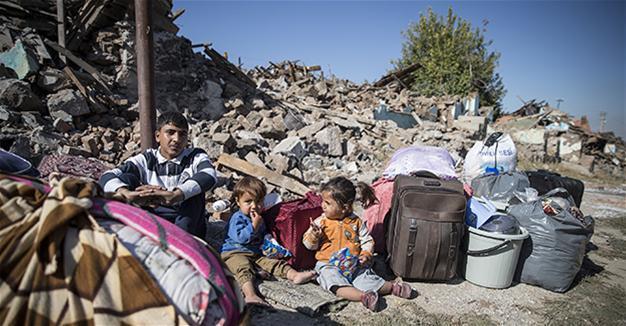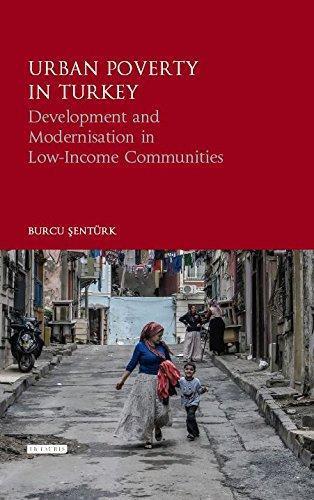Urban poverty in Turkey
William Armstrong - william.armstrong@hdn.com.tr

Syrians living in shanty houses and derelict buildings in the Turkish capital were recently evacuated as a part of an urban transformation project overseen by the Ankara Municipality. AA photo
‘Urban Poverty in Turkey: Development and Modernisation in Low-Income Communities’ by Burcu Şentürk (IB Tauris, 196 pages, £64)
The issue of urbanization provides a rich window to explore Turkey’s modern history. Chaotic transformations in urban demographics are at the center of broader shifts in Turkish politics and society. Starting in the 1950s, there was a steady rise of people building “gecekondu” slum homes on the urban periphery. Gecekondu dwellers comprised 4.7 percent of Turkey’s urban population in 1955, 16.4 percent in 1960, 22.9 percent in 1965, 26.1 percent in 1980, and 35 percent in 1995. By the first half of the 1960s, 59 percent of the capital Ankara’s population and 45 percent of Istanbul’s population lived in gecekondus.

For her research for “Urban Poverty in Turkey,” Ege University academic Burcu Şentürk spent years living in the Ege area of Ankara’s Mamak district, giving her a unique insight into these changes. Her book is a rewarding exploration of Turkey’s wrenching economic, political and social shifts through close study of a single gecekondu neighborhood in Ankara over decades of change.
Migrants first started moving to Ege in the 1960s, mostly from rural parts of the nearby provinces of Çorum, Yozgat and Sivas. The early settlers built their homes overnight and defended them from municipal bulldozers. Conditions were very tough: There was no electricity, water or sewerage, nor were there proper roads or public transport into the city center.
This struggle for infrastructure was formative for the community. Locals cooperated for the improvement of Ege throughout the 1960s and 70s to secure their existence in the city. The link between Ege residents and left-wing groups was strong. Leftist activists often came from within gecekondu areas, so there was organic solidarity between them and struggling locals. Şentürk quotes the veteran leftist politician Sırrı Süreyya Önder, who was active in Ege in the 1970s, describing “left-leaning gecekondu areas [as] a kind of shelter for activists from socialist groups.”
Ege, which was often referred to as “little Moscow,” was particularly comfortable with leftist activism because a majority of its residents were from the Alevi religious minority. Through the 1970s, parts of Turkish cities were in a state of bloody near-civil war as left-wing and right-wing militia clashed. Alevis were generally closer to leftist groups and Sunnis emphasized right-wing nationalism. Many were killed every day. Segregation between left-wing and right-wing gecekondu areas meant that people often could not safely enter neighborhoods with a different political ideology. Interviewees tell Şentürk that it was quite usual in the 1970s for local young people at the entrance of each gecekondu area “to ask strangers whether they were Alevi or Sunni, left-wing or right-wing in order to protect their neighborhood from the ‘fascists.’”
But improving the lot of gecekondu neighborhoods demanded cross-border solidarity. Alevis and Sunnis banded together when it came to ameliorating conditions in their local neighborhood. “The redefinition of ‘us’ and ‘them’ in terms of being Alevi or Sunni disappeared when it came to the collective needs of the Ege community. Being a right-wing, Sunni person did not prevent them from acting collectively with the majority who were Alevi and leftist,” Şentürk writes. “Although they had different faith backgrounds and places of origin, their new situation in the city was similar in terms of their immediate needs for jobs, housing and infrastructure and they shared a feeling of exclusion from participating in city life.”
This may be over-romantic. Şentürk quotes present-day locals thinking back nostalgically to the era, but their remembered examples may just be isolated instances of cooperation, against the more powerful general tide of deadly ideological polarization at the time. As Şentürk also reports, many locals “considered the political polarization of the pre-1980 period as a state of terror.”
Either way, the 1980 military coup was a decisive turning point. Turkey’s military regime brutally cracked down on leftist activism. The chaotic politicization of the 1970s was replaced by state-enforced silence and depoliticization. “The leftist movement disappeared in gecekondu neighborhoods and people became afraid to come together and act collectively,” Şentürk writes. As a result, “after the 1980s, the link between the identity and labor of gecekondu dwellers broke down.”
Neoliberal economic policies fueled this process. The pursuit of export-led manufacturing-based growth increased demand for cheap and unskilled labor, prompting a new wave of migration to Turkish cities through the 1980s. The sharp drop in state subsidies to rural agricultural producers also led to a fresh influx of migrants. These newcomers’ work and home ownership situation differed from previous Ege residents, and solidarity among gecekondu dwellers decreased as their interests began to diverge. What’s more, with left-wing activity suppressed and unable to bring the community together, there was far less collective struggle after the 1980 coup. Basic issues for which the earlier generation campaigned had already been solved, so the sense of community started to dissolve.
“Urban transformation” projects from the 1990s made clear the breakdown in community solidarity. Areas like Ege were cited for regeneration, with the authorities replacing gecekondu plots with new apartment blocks. Locals who owned their property’s title deed were compensated when construction firms demolished it; those without a title deed were essentially forced out of the area. The latter returned to earlier solidarity practices, waging a collective struggle for their housing rights alongside various leftist groups. But this was different from previous solidarity, as leftist activists now came from outside the gecekondus. Before the 1990s, Şentürk writes, “there was an organic relationship between the left-wing and gecekondu people [and] the left did not support the struggle of gecekondu people from the outside.” Also different was the fact that the neighborhood was divided by interests: Gecekondu dwellers with formal title deeds did not contribute to the struggle of the dispossessed occupiers.
“Urban Poverty in Turkey” explores this process in detail. But there are other aspects that it misses. A key part of the gecekondu story of the past few decades is the crucial role the urban periphery played in the rise of political Islam in Turkey. Of course, Islamist mobilization in the Alevi-majority Ege neighborhood is not critical. But a deeper recognition of this aspect would make Şentürk’s book more complete.
Sociologist Sevinç Doğan’s recently published “
Mahalledeki AKP” (AKP in the Neighborhood) explores how the ruling party operates on the ground on the hardscrabble urban periphery. Anthropologist Kayhan Delibaş’s “
The Rise of Political Islam in Turkey” is also an important read on how Islamist groups built their political base by providing services to impoverished urban areas in the 1980s and 90s. Read together with these two books, “Urban Poverty in Turkey” gives a good overview of the urban dynamics that have defined Turkish society in recent decades.
*Follow the Turkey Book Talk podcast via iTunes here, Stitcher here, Podbean here, or Facebook here. 
 For her research for “Urban Poverty in Turkey,” Ege University academic Burcu Şentürk spent years living in the Ege area of Ankara’s Mamak district, giving her a unique insight into these changes. Her book is a rewarding exploration of Turkey’s wrenching economic, political and social shifts through close study of a single gecekondu neighborhood in Ankara over decades of change.
For her research for “Urban Poverty in Turkey,” Ege University academic Burcu Şentürk spent years living in the Ege area of Ankara’s Mamak district, giving her a unique insight into these changes. Her book is a rewarding exploration of Turkey’s wrenching economic, political and social shifts through close study of a single gecekondu neighborhood in Ankara over decades of change.